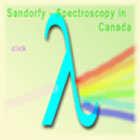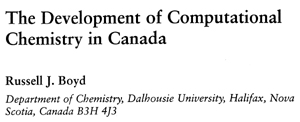 |
Camille Sandorfy
|
 |


In the Beginning there was Quantum Chemistry and Spectroscopy.
The early efforts in quantum chemistry in Canada, as in other countries,
were closely connected with electronic spectroscopy. Later the scope expanded
to include all forms of spectroscopy. One of the Canadian pioneers whose
interests epitomize the history of quantum chemistry is Camille Sandorfy.
After
graduating from the University of Szeged in bis native Hungary and completing
a D.Sc. under the supervision of Profs. Louis de Broglie and R. Daudel at the
Sorbonne in Paris, Sandorfy took up a postdoctoral fellowship with Dr. R.
Norman Jones, a spectroscopist at the National Research Council of Canada
laboratories in Ottawa. By the end of 1953, Sandorfy bad settled in Montreal,
where he began a highly distinguished career, initially as a theoretical chemist
and ultimately as a full-time spectroscopist, specializing in the far-ultraviolet
and infrared regions. He developed the basis for a very strong group in quantum
chemistry that continued to flourish under the leadership of Dennis Salahub
and his younger colleagues at the University of Montreal.
In the years 1945-1955 theoretical chemists as well as chemical
spectroscopists concentrated their efforts on systems containing pi-electrons.
Such
molecules can be easily treatcd by simple molecular orbital methods. lt was
considered a normal procedure in those times to treat the pi electrons as a
separatc quantum chcmical problem to which the sigma-electrons supply a
supposedly uniform potential field.
Sandorfy was struck by the artificial character of this approximation. His
first target was the series of normal chain saturated hydrocarbons. A
preliminary note on his results was published in the Comptes Rendus de l'Académie
des Sciences. After taking up his position in Montreal, he greatly extended this
work by introducing three different approximations, which he called the “C“
“CH,“ and “H“ approximations. The first was based only on the atomic
orbitals of the carbons, the second used the hybrid sp3 orbitals
of the carbons
and the ls orbitals of the hydrogens, and the third included all the valence
atomic orbitals of the carbons and the hydrogens.
These methods appear rather simple, yet they were the starting point of a
long evolution.
Gilles Klopman,
whose research interests at Case-Western Reserve University later turned to
modeling bioactive molecules, was the first to
use Sandorfy's methods.
Kenichi Fukui made extensive use of them in his wellknown
work on the structures and reactions of saturated hydrocarbons and
their derivatives. Fukui added bis frontier orbital considerations. Around 1959
the milieu of developments in quantum chemistry contributed to inspire
William N. Lipscomb to conceive the extended Hückel method, which was
subsequently implemented by Lawrence L. Lohr and
Roald Hoffmann. Soon thereafter,
John Pople
and his coworkers introduced self-consistent field
methods based on the zero-differential overlap approximation.
The arrival of ab initio programs based on Gaussian-type orbitals and
more powerful computers reduced all these developments to historical souvenirs.
lt shouid be emphasized, however, that Sandorfy's work constituted the
first attempt to go beyond the pi-electron approximation, and the first molecular
orbital treatment of polyatomic molecules that took into account all valence
electrons without using group orbitals.
From among Sandorfy's subsequent theoretical projects, two in particular
should be mentioned: the first treatment of the excited states and electronic
spectra of saturated hydrocarbons by a new pi-electron method of the Pariser—
Parr type, and the first attempt to introduce Rydberg orbitals into molecular
orbital calculations.
In 1964 Sandorfy and his coworkers initiated an extensive experimental
project to explore the electronic absorption spectra of saturated molecules in
the far-ultraviolet region. Their first spectra of a series of paraffin
hydrocarbons
were published in 1967. This paper coincided with an article, also giving
spectra of hydrocarbons, by J. Raymonda and W.T. Simpson. While there
was general agreement between the recorded spectra of the two groups, the
investigators' interpretations were different; it was Sandorfy and his coworkers
who put the spectroscopy of the paraffins on the right track by adopting an idea
of R.S. Mulliken that related to the Rydberg character of the bands of lowest
frequency found in their spectra. In this case too, a long evolution was
forthcoming. The field has been summed up by M. B. Robin and, more concisely,
by Sandorfy.
Today, after many years of work in several laboratories the
spectroscopy of sigma-electron systems has advanced to a level previously
attainahle
only for simple pi-electron Systems; it is possible, in a qualitative manner, to
predict the bands that a given organic molecule, saturated or unsaturated,
either heteroatomic or not, should possess in the near- or far-ultraviolet regions.
Ultraviolet photoelectron spectroscopy helped greatly during this work of
exploration.
Camille Sandorfy is acknowledged as the first theoretical chemist to be
appointed to the faculty of a department of chemistry in Canada. It is therefore
fitting that he was the first theoretician to be honored by a special issue of the
Canadian Journal of Chemistry. The 750-page special issue for July 1985
contained 117 papers spanning a broad range of topics relating to spectroscopy and
theoretical chemistry. The Sandorfy issue is by far the largest issue the Canadian
Journal of Chemistry has published. It was edited by two of his former Ph.D.
students and younger colleagues at the University of Montreal, Gilles Durocher
and Dennis Salahuh, the former a spectroscopist and the latter a theoretical
chemist.


Last updated : Feb. 10, 2002 - 17:05








